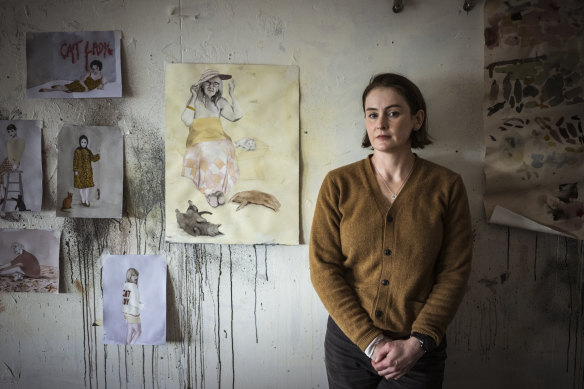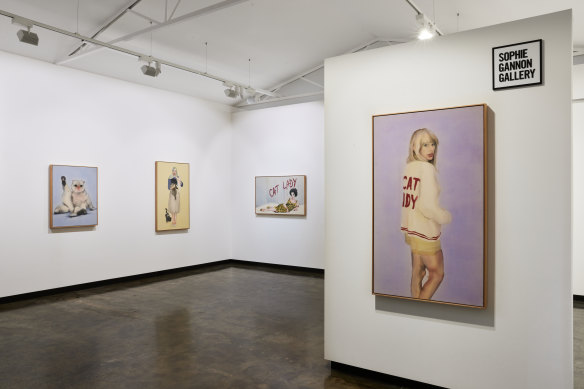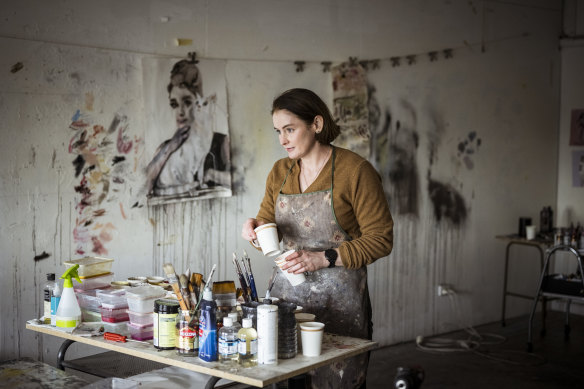By Cara Waters
Fiona McMonagle really wants to know why there is no such thing as a “cat man”.
“I’ve always been interested in the labels that are placed on women and ‘cat lady’ just always stuck with me,” the Melbourne artist says.
“It’s lazy pop-cultural shorthand that implies: A single, lonely, eccentric, sexless woman who cannot hold down a man and so turns to her cats for companionship.”

Artist Fiona McMonagle explores the trope of the cat lady, a label she says is sexist.Credit: Chris Hopkins
McMonagle’s new exhibition, Cat lady, which opened this week, explores the age-old stereotype through nine paintings portraying some of pop culture’s most iconic women, who all just happen to love cats.
Elizabeth Taylor, Eartha Kitt, Marilyn Monroe, and Taylor Swift, who McMonagle describes as “the poster girl for cat ladies”, are all featured in the series of portraits.
Swift regularly poses with and posts about her three cats, Meredith Grey, Olivia Bensen and Benjamin Button, and when Time anointed her as its Person of the Year for 2023 she had one query for the photo shoot: “Can I bring my cat?”
“She’s one of those celebrities trying to turn the trope on its head and trying to reclaim the label,” McMonagle says. “It’s a sexist label. There’s no equivalent label for a man who loves cats.”
In ancient times, felines and female deities went hand in hand with Bastet, the Egyptian goddess of domesticity, childbirth and women’s secrets portrayed as a half-cat, half-woman.
However by the Middle Ages single, unmarried women faced accusations of witchcraft and rumours spread of women being able to turn themselves into cats.
This attitude prevailed until the 1800s when society became less superstitious but negative connotations of the relationship between cats and women remained with the term witch swapped for “old maid”, which eventually landed on “cat lady and even “crazy cat lady”.

Fiona McMonagle’s Cat Lady exhibition at Sophie Gannon Gallery. Credit: Fiona Storey
McMonagle says while women are pushing back against their experiences with sexism, the negative stereotype of the cat lady still persists.
She points to video resurfacing this week of Donald Trump’s vice presidential candidate J.D. Vance saying “we are effectively run in this country … by a bunch of childless cat ladies who are miserable at their own lives and the choices that they’ve made”.
“So long as you’ve got people like that making comments like that, it’s still a little bit scary,” McMonagle says. “It’s a joke still, but women no longer have to pretend to find it funny any more.”
In Australia dogs are the more popular pet, with data cited by the RSPCA from 2022 calculating there are 5.3 million pet cats in Australia, in comparison to 6.3 million pet dogs.
The most recent data dividing pet ownership by gender comes from research by Roy Morgan in 2015, which found that approximately 1.3 million cats were owned by women and 1 million were owned by men.

Fiona McMonagle really wants to know why there is no such thing as a “cat man”.Credit: Chris Hopkins
Melbourne University associate professor Lauren Rosewarne says the number of “cat ladies” is likely to rise with single woman households one of the biggest growing demographics.
“The overarching idea with the cat lady stereotype is that the woman is single and doesn’t have children,” she says. “That idea reflects a very long history of women’s value to society and perceived value to society being hinged on whether she’s attractive enough to catch a husband and fertile enough to give him children.”
Rosewarne says the stereotype is that if a woman has not been chosen by a man or reproduced she is not of value to society, but she says this narrative is changing.
“It’s still used as a derogatory term, but at the same time there’s a change in terms of how women perceive it as related to the level of insult,” she says.
“There’ll be, for example, people who still find it insulting and who will be defensive about it, whereas there will be others who say ‘Don’t threaten me with a good time’, who will see this as a badge of honour.”
Cat Lady is showing at Sophie Gannon Gallery in Richmond until 4 August.
Start the day with a summary of the day’s most important and interesting stories, analysis and insights. Sign up for our Morning Edition newsletter.